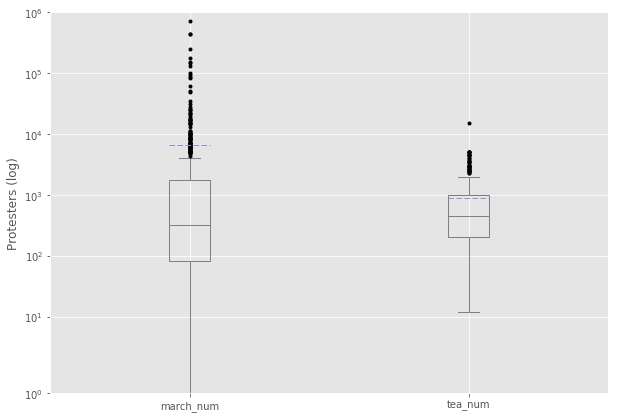The Tea Party protests took the country by storm in 2009 and had an outsized impact on the legislative process. The recent Women’s March and associated movement could have a similar effect, so I was curious to see how the two compared in size and location. Below, I look at the distribution and size of the marches, compare turnout by city, then look at the fraction of each state that attended protests.

Overall, there were ten times more Women’s Marchers (4,157,678) than Tea Party marchers (310,960). Interestingly, both protests had a similar median number of marchers (322 vs 450), although the mean was substantially higher for the Women’s March (6673 vs. 903). Finally, almost every state had a larger percentage of the population turnout for the Women’s March, with Colorado leading the way at 2.9%. This means that although the march was more concentrated in cities, it was still a grassroots event distributed geographically throughout the 50 states.
If the energy from the Women’s March is put to use, it could have an even larger impact than the Tea Party. We may be seeing the results in congress and town halls already.
Data Sources
Jeremy Pressman, Erica Chenoweth and others recently finished compiling all the Women’s March data and 538 compiled data on the Tea Party protests a few years ago, so I used both those sources. I got the state level population data from the US Census, and the voter turnout data from David Wasserman. All these sources are available in a zipped file here.
All the code for this post is available in a Jupyter notebook here.
Marchers by City
First, I look at this data by city. The boxplot shows that the median march size was actually very similar between cities (322 vs 450). The mean, however, was an order of magnitude higher for the Women’s March (6673), and there are more outliers at the high end of the march size. There were also ten times more Women’s Marchers (4,157,678) than Tea Party marchers (310,960).

| march_num | tea_num | |
|---|---|---|
| count | 623.000000 | 344.000000 |
| mean | 6673.641091 | 903.953488 |
| std | 42193.461677 | 1308.635137 |
| min | 1.000000 | 12.000000 |
| 25% | 80.750000 | 200.000000 |
| 50% | 322.500000 | 450.000000 |
| 75% | 1725.000000 | 1000.000000 |
| max | 725000.000000 | 15000.000000 |
Below is an interactive scatter plot of the number of protesters in each city for each movement. This is created using an outer join, so the assumption is that any cities not shared by both lists had protesters for one event and and not the other.
Any city above the 45 degree line had more Tea Party Marchers, and those below had more Women’s Marchers. These are log axes, so the cities do skew substantially towards the Women’s march (especially the large ones).
Here’s a table showing the data from the scatter plot above. Click the headers to sort it by any of the columns:
Binned and Counted
This next plot groups the marches by size and counts them. It’s clear that the majority of both protests took place in groups of 200,000 or less, and that the Women’s March dwarfed the Tea Party in size.
One issue that makes these number hard to interpret is that Democrats may have a higher baseline protest rate because they’re more concentrated in cities. It’s less of an ask to get people to walk out their front doors than to get someone to drive a few hours to a city to protest. Still, the Democratic numbers seem abnormally high.

Marchers by State
Next, I look at the marchers grouped by state. Every state except West Virginia had a larger percentage participate in the Women’s March, with Colorado leading with 2.9% of their population. California had the largest total number of protesters, at 910,830.

Did blue states have more marchers?
The Democratic margin for president is a fairly good indicator for the Women’s March participation. Some states overperformed (CA, OR, MA, VT, WA, IL) or underperformed the linear regression line, although some of the underperformers are states adjacent to DC.

Conclusion
Overall, this is pretty encouraging for Democrats. The main challenge now is to harness this energy for political change. Recent attendance at town halls and activism from grassroots organizations suggests this might already be happening.